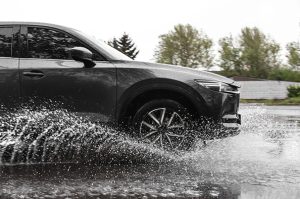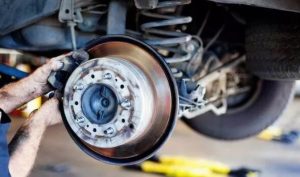Braking is one of the most critical aspects of vehicle safety — and it’s also one of the most affected by weather conditions. Whether it’s heavy rain, icy roads, or scorching heat, different weather elements can significantly alter your car’s braking performance. As a responsible driver, understanding how these conditions impact your brakes and knowing how to adapt can make all the difference in safety and confidence behind the wheel.
In this article, we’ll explore how various weather conditions affect braking, what risks they pose, and what proactive steps you can take to stay safe in all seasons.
Why Weather Matters in Braking Performance

Braking systems rely on friction — between the brake pads and rotors, and between the tires and the road. Weather can alter this friction in different ways:
-
Water or ice reduces road grip
-
Cold temperatures affect brake materials
-
Heat can lead to brake fade
-
Humidity influences corrosion and performance
Effects of Weather on Braking: A Quick Overview
| Weather Condition | Effect on Braking | Potential Risk |
|---|---|---|
| Rain/Wet Roads | Reduced tire traction, longer stopping distance | Hydroplaning, brake fade |
| Snow and Ice | Severely reduced grip, ABS may engage frequently | Skidding, extended stopping distance |
| Extreme Heat | Brake pad fade, boiling brake fluid | Reduced braking efficiency |
| Cold Temperatures | Harder brake pads, less friction | Sluggish braking response |
| Humidity | Moisture in brake fluid, rust on components | Corrosion, spongy pedal feel |
1. Rain and Wet Roads
What Happens:
Rain creates a thin layer of water on the road, reducing tire traction. If your brake pads or rotors are wet, initial braking can feel delayed until the water is burned off through friction.
Risks:
-
Longer stopping distances
-
Hydroplaning
-
Reduced brake response
How to Minimize Risk:
-
Drive slower and leave more space between vehicles
-
Use properly grooved tires for better water displacement
-
Check your brakes regularly for wear
-
Avoid sudden braking
2. Snow and Ice
What Happens:
Snow and especially ice drastically reduce road grip. Even with ABS (Anti-lock Braking System), it can take significantly longer to stop.
Risks:
-
Skidding or sliding
-
Loss of steering control
-
Longer braking distances even at low speeds
How to Minimize Risk:
-
Switch to winter tires with better traction
-
Brake gently and early
-
Use engine braking (downshifting) when possible
-
Avoid using cruise control
3. Extreme Heat
What Happens:
During hot weather or high-speed braking (like in mountainous terrain), brake components can overheat. This causes a condition known as brake fade, where the braking force diminishes even when you apply the pedal.
Risks:
-
Brake pedal feels soft or spongy
-
Longer stopping distance
-
Potential brake fluid boil
How to Minimize Risk:
-
Avoid “riding” the brakes on long descents
-
Use engine braking when going downhill
-
Install high-temperature resistant brake pads
-
Flush brake fluid regularly to prevent moisture buildup
4. Cold Temperatures
What Happens:
In freezing temperatures, brake pads (especially semi-metallic types) can become harder, which may reduce their friction efficiency. ABS systems may engage more often due to reduced grip.
Risks:
-
Decreased initial braking response
-
Cracking of worn-out pads
-
Reduced grip, especially with all-season tires
How to Minimize Risk:
-
Warm up the car and brakes gradually
-
Check brake components for brittleness
-
Use winter-grade brake pads if available
5. Humidity and Moisture
What Happens:
High humidity or wet weather can introduce moisture into the brake fluid, lowering its boiling point and making the brakes feel spongy. It also accelerates corrosion on rotors and calipers.
Risks:
-
Rust buildup on rotors
-
Brake fluid degradation
-
Reduced brake responsiveness
How to Minimize Risk:
-
Flush brake fluid every 2 years
-
Use DOT4 or higher brake fluid with moisture resistance
-
Store the vehicle in a garage or covered area when possible
-
Drive the car regularly to prevent rust buildup
Weather vs. Braking Performance: Comparative Table
| Condition | Brake Issue | Driver Action |
|---|---|---|
| Rain | Hydroplaning, weak initial braking | Slow down, use quality tires, brake earlier |
| Snow/Ice | Slipping, ABS overuse | Use winter tires, gentle braking, increase stopping gap |
| Heat | Brake fade, fluid boil | Use engine braking, high-temp pads, fluid maintenance |
| Cold | Hard pads, slow reaction | Warm up brakes, check for wear, switch pad type |
| Humidity | Rust, moisture in fluid | Garage storage, fluid flush, regular driving |
Best Brake System Features for Weather Adaptability
If you often drive in harsh weather, consider upgrading your brake system with features that handle extreme conditions better:
-
Slotted or Drilled Rotors – Help dissipate heat and moisture
-
Ceramic Brake Pads – Perform well across a range of temperatures with less dust
-
High-Temp Brake Fluids (DOT 4 or DOT 5.1) – Better boiling points for hot and humid conditions
-
Rust-Resistant Coated Rotors – Ideal for humid or coastal environments
Additional Tips to Improve Braking in All Weather
-
Keep your tires in good condition and properly inflated
-
Do regular brake inspections, especially before seasonal changes
-
Listen for noises or vibrations — signs of worn components
-
Don’t overload your vehicle — it increases stopping distance
-
Replace worn pads with quality components for optimal safety
Trusted Brake System Brands

To ensure consistent performance regardless of weather, use high-quality components from proven manufacturers:
-
Brembo
-
Bosch
-
ATE
-
Zimmermann
-
TRW
-
Ferodo
You can explore a wide range of weather-resistant braking components from top brands by visiting
Buy Brake System online
Final Thoughts
Weather is unpredictable, but your braking performance doesn’t have to be. Understanding how climate affects your car’s brakes helps you drive smarter and safer year-round. Whether you’re facing a summer heatwave or a winter whiteout, adapting your driving style and maintaining your brake system is crucial.
Be proactive — inspect your brake system regularly, choose weather-suitable components, and upgrade when necessary. When it’s time to replace parts or upgrade your braking system, head to Buy Brake System online to find reliable, weather-ready products that match your driving needs.